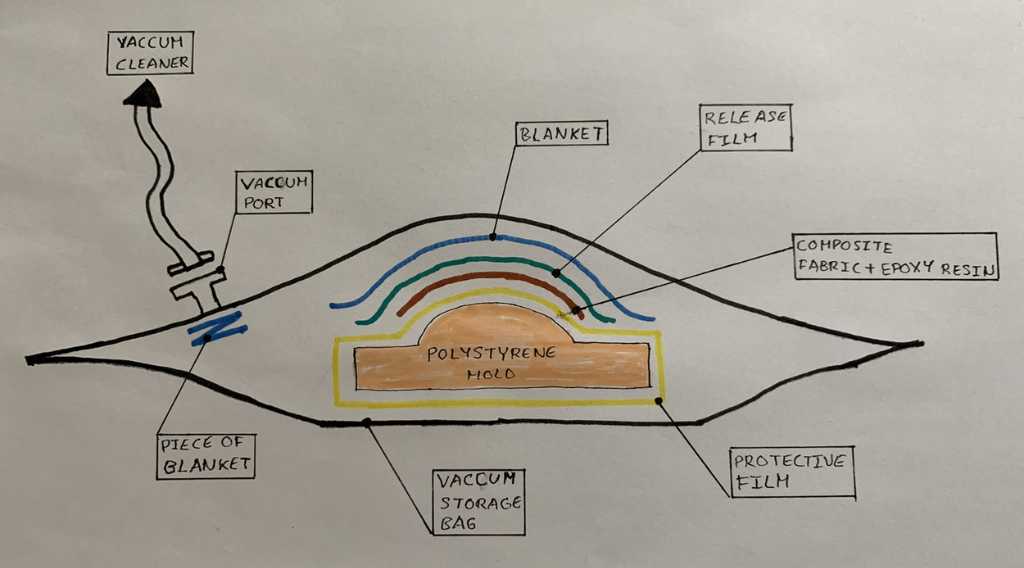lecture notes¶
this weeks lecture¶
make sure to also ducumnet the requirements that your assignment meets.
EDM = electrical discharge machining. Used to make metal parts with high quality surface finish.
Waterjet cutters consume a lot of garnet.
composites¶
composites is the most underused process. You can make strong, lightweight objects.
composites involve fibers and matrix.
Adrian shared an image of composite process:

There are a number of materials that are strong in tension, but weak at compression (for example clothes, you cannot pull them apart, but they’re still flexible). There are a number of materials that are really strong, you cannot compress them, but weak in tension (if you stretch it, it cracks). Composites combine the both. The fiber makes is strong in tension, the matrix makes it strong in compression.
Adobe clay = natural clay with natural fiber reinforcement.
Wood is a composite as well: wood fiber with resin matrix.
Other examples: concrete + rebar, epoxy + carbon fiber.
For fibers, long fibers are better than chopped fibers. Chopped fibers is better than no fibers. So use continuous sheets of fibers.
Common fiber sources are glass, carbon, aramid, kevlar. There’s are not mainly used in Fablabs. Carbon for example is hazardeous to use. Fablabs like to use natural fibers from sustainable sources: cotton, silk, bamboo, wood, linen, burlap.
For the matrix, there is a number of options. Most commonly used is epoxy, but traditional epoxy is not environmentally sustainable and healthy. Other traditional martrix materials: polyester, urethane wax, cement. There’s a lot of work done on natural matrix material like plany resins, sugars.
Significant bio-based epoxy is made by Entropy Resins (not open source).
State of the art composites are made by Toray, Gurit, Exel… (i,.e. airplanes, windmills).
Key concept is the plies of the composites. You need a thickness created by multiple plies of fibers. In between, little holes are needed where epoxy can go in. Common in composites is that you have a core that is used to reduce mass. For example honeycombs, foams, cardboard. So it’s the top and bottom of a composite that create the strength. When using a light core, the core just stays inside.
Important in the composite production process is that you need to compress, squish the fibers together. This is because the majority of strength of composites comes from the fibers, not the resin. So you need to force the resin into the fabric/fibers and get rid of the excess epoxy.
The closer the fibers come together, the better the composite is with regards to stiffness versus weight.
One way to create mass is to fill a trashbag with water and use that as a weight. More common is to put the hole thing into a bag and pull a vacuum. The airmass creates the mass.
But the best way is to clamp it, using a barclamp. But if the mold is really big, there will not be a lot of force in the middle.
Coupons is a test composite. You make a simple rectangular strip out of the composite and you use that to test. From fabacademy tests, linen showed to have good properties.
If you use a closed mold and you clamp it, you don’t need vacuum. This is increasingly used in the industry. It is a better technique than vacuum bagging because you get more compaction.
wet lay-up = infuse the fibers with epoxy and then lay them on or in the mold.
pre-preg = you buy the fibers with the resin already in it.
RTM = resin transfer molding.
Vacuum bagging techniques
A good appnote how to do vacuum bagging is in this PDF from West System.
In bigger molds, it is hard to get the excess resin out. That’s why commonly used is a bleader and a breather: a sheet with holes (perforated film) and e.g. soft cotton. The excess resin will go through the holes of the bleader and gets absorbed in the breather.
Autoclav = oven & pressure or vaccum to cure the resin/epoxy.
Composites don’t come out of the mold all clean and shiny. It’s a bit rough. A clear coat finish is used to make it shiny.
Safety¶
stay away from glassfiber and carbonfiber. They are quite harmless when not made into a composite yet (you can cut them with scissors). But when made into a composite, anything you do to it (drill, sand, machine, etc) creates short fibers. If you breath this, they get in your lungs and they don’t leave. So you’ll get lung disease. You need a heavy duty respirator that also protects your eyes.
Serious epoxies need very good ventilation. Even natural expoxies need ventilation. Also wear gloves, goggles, etc.